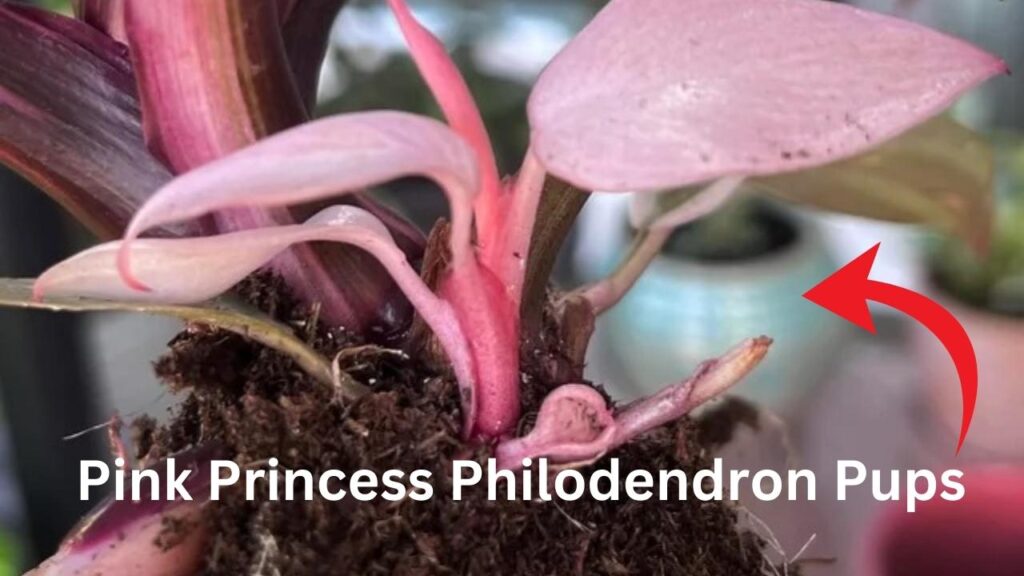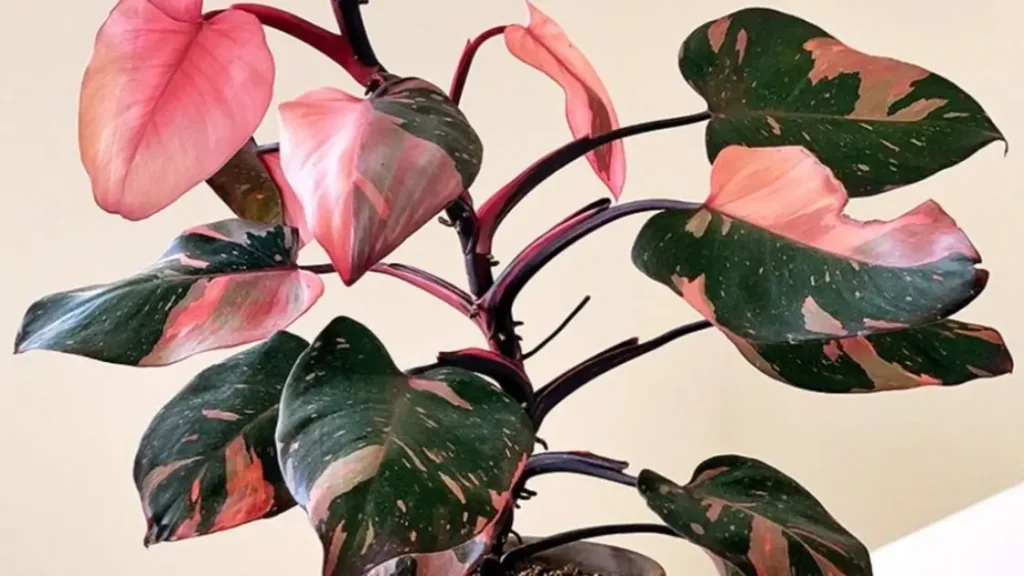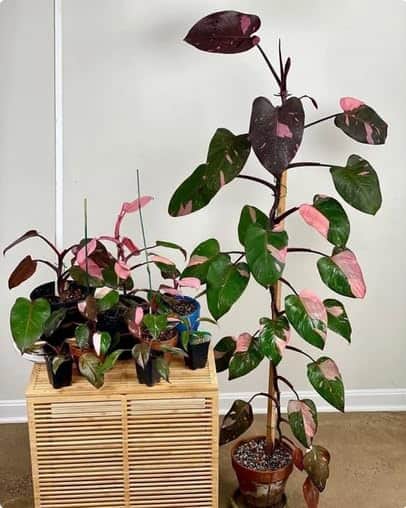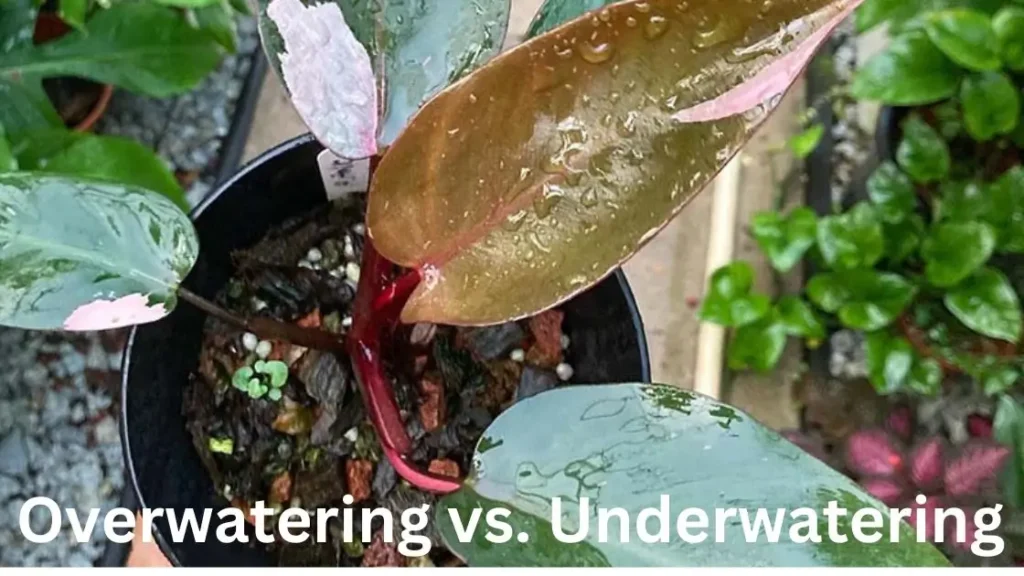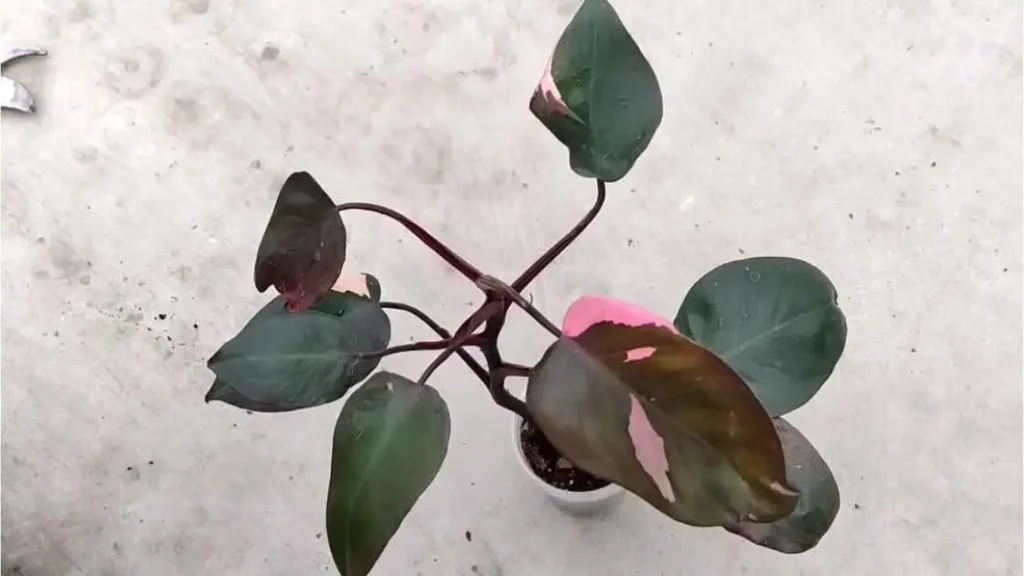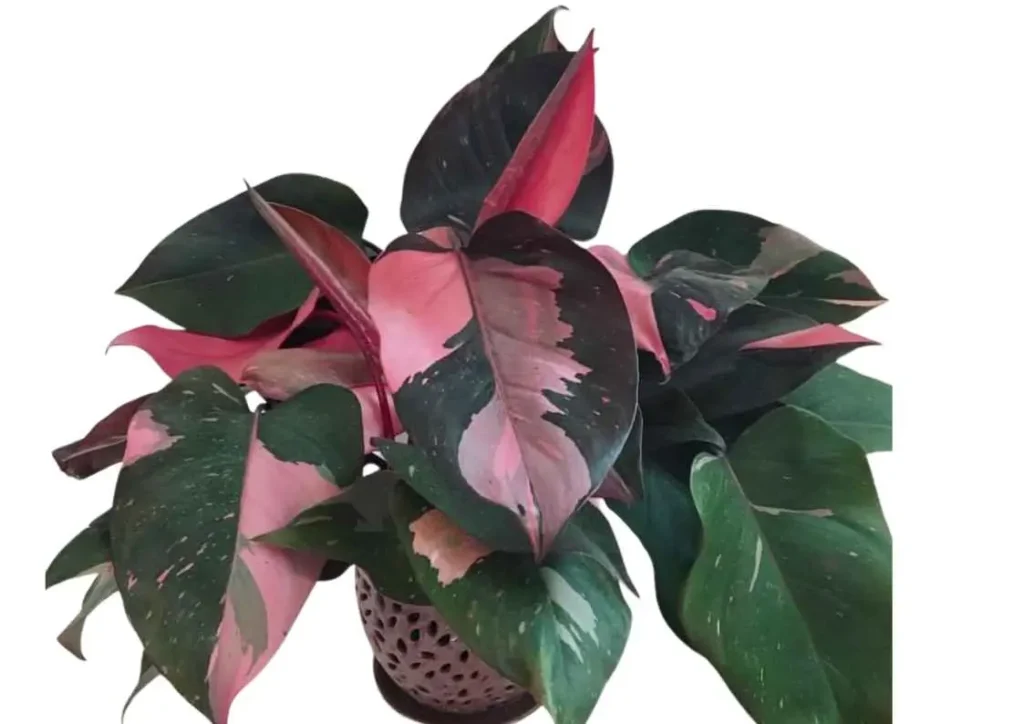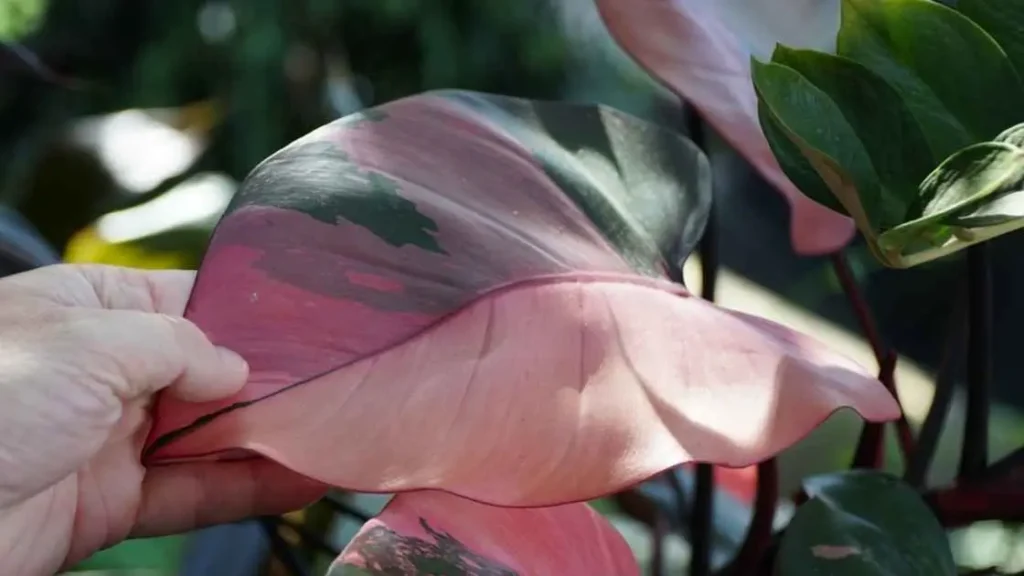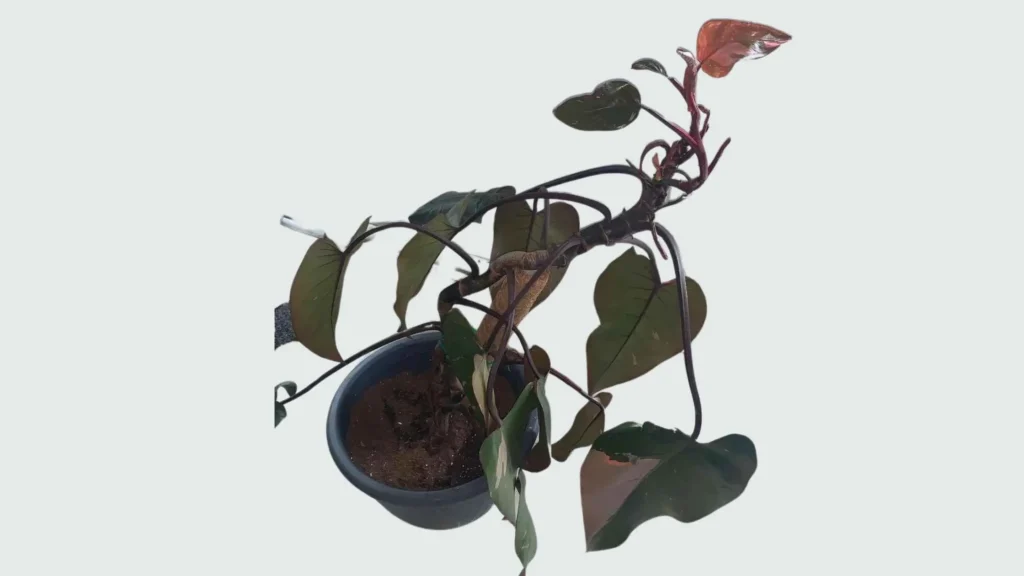Table of Contents
ToggleToday, I want to talk about something that can help your Pink Princess Philodendron grow better: pruning. If you want to keep those pretty pink and green leaves looking great, this is for you. Pruning does more than just tidy up your plant; it helps it grow stronger, keeps the colors bright, and keeps the plant healthy.
In this guide, I’ll show you why pruning is important and how to do it right. Plus, I’ll give you tips to avoid common mistakes. By the end, you’ll know how to help your Pink Princess grow and thrive.
Why Pruning is Essential for Pink Princess Philodendron?
If you have a Pink Princess Philodendron, you know how pretty its pink and green leaves are. But to keep it looking good and growing well, you need to prune it often. Pruning isn’t just about looks, though that’s a big part of it. It also helps the plant stay healthy and grow strong. Let’s talk about why pruning your Pink Princess is more important than you may think.

Maintaining Shape and Size
One of the main reasons I suggest pruning your Pink Princess is to keep it in shape. Over time, the plant can get “leggy,” which means long stems with fewer leaves, especially when it’s reaching for light. By cutting back those longer stems, you help the plant focus its energy on growing fuller, healthier leaves. This keeps your Pink Princess looking lush and balanced.
If you’re like me and love a full, bushy plant, regular trimming will help you get that look. Plus, it gives you control over how big the plant gets, which is super helpful if you’re short on space, like in an apartment or on a shelf.
Encouraging New Growth
Think about how, after a haircut, your hair grows back stronger. The same thing happens with your Pink Princess Philodendron. When you prune it, especially by cutting off old leaves and stems, it helps the plant grow new ones. This is because the plant uses its energy to grow fresh, healthy leaves instead of keeping the older parts alive.
Pruning is also key if you want more of that pretty pink color. Cutting your plant can encourage new leaves to grow, and these might have better pink coloring. I’ve found that trimming above a node (the spot where leaves grow from the stem) can lead to new shoots, and sometimes, even more pink leaves.
Preventing Diseases
One big reason to prune plants is to stop diseases. Houseplants, like the Pink Princess, can get sick with fungus or pests if not pruned often. When parts of the plant die or get hurt, diseases can spread to the healthy parts.
By cutting off dead or damaged leaves and stems, you help keep the plant healthy. This also lowers the chance of disease. Pruning also improves airflow around the plant, which helps stop things like root rot or fungus. I always check for leaves or branches that look bad. If I see any, I cut them right away to stop bigger problems later.
Boosting Aesthetic Appeal
One reason we love the Pink Princess is for its bright pink leaves. Pruning helps keep the plant looking beautiful. A well-pruned plant looks healthier and keeps its pink color.
Without pruning, the plant might grow more green leaves than pink ones. It could also get long and thin, losing its full shape. By cutting certain stems, especially ones without the pink color, you help the plant focus on growing new, colorful leaves. The more you prune, the better chance your Pink Princess will stay a showpiece.
When to Prune Your Pink Princess Philodendron?
Pruning can seem a little scary at first, especially with a rare plant like the Pink Princess Philodendron. I understand the worry—what if you prune too much or at the wrong time? But once you learn when to prune, it gets easier. You’ll feel more confident in shaping your plant. Let me show you the best time to prune so you can do it without any stress.
The Best Time to Prune
The best time to prune your Pink Princess Philodendron is in spring or early summer. During this time, the plant is growing and can recover from pruning faster. The warm weather and extra sunlight help the plant grow new stems and leaves, making it a good time to trim.
After pruning in the spring, I’ve noticed my Pink Princess grows new leaves faster, often with more pink. If you want brighter pink leaves, spring is the best time to prune.
Why You Should Avoid Winter Pruning?
Now, let’s talk about when not to prune—winter. This is when the plant is resting and not growing. If you prune during the cold months, your plant may struggle because it doesn’t have the energy to grow back quickly. Pruning in winter can even harm the plant and slow its growth.
So, if your Pink Princess looks messy in winter, don’t prune it. Instead, focus on giving it the right light, humidity, and water. Save the pruning for when the days get longer and warmer. Your plant will thank you!
Signs That Your Plant Needs Pruning
If you’re wondering when to prune, here are some signs to watch for:
- Long stems with few leaves: If your plant is stretching for light, it needs a trim.
- Yellow or damaged leaves: Cut off any leaves that are yellow, damaged, or sick to stop disease from spreading.
- Overgrowth: If your Pink Princess is getting too big, pruning can help control its size and shape.
It’s good to check your plant often. Even a small trim can make a big difference in how healthy it looks.
Final Tip on Timing
Remember, while spring and early summer are the best times to prune, you can still do small trims throughout the year. If you see a damaged leaf or a bit of overgrowth, feel free to cut it. Just keep in mind that bigger pruning jobs should wait for the growing season. This way, the plant will have the energy to recover and grow well.
Tools and Materials Needed for Pruning Your Pink Princess Philodendron
So, you’re ready to prune your Pink Princess Philodendron. Before you start, make sure you have the right tools. You don’t want to harm your plant by using dull or dirty tools. Let’s go over everything you’ll need to make pruning easy and safe.
1. Sharp Pruning Shears
The main tool you need is a pair of sharp pruning shears. Sharp blades are very important. Dull blades can crush or tear the stems, making it hard for the plant to heal and can cause infections. A clean, sharp cut helps keep the plant healthy.
I use small garden shears that are easy to handle and can fit in tight spaces between leaves. If your Pink Princess is small, you can use sharp scissors, but garden shears work best.
2. Rubbing Alcohol or Disinfectant
Before you start cutting, it’s important to clean your tools. Many people forget this step, but it helps stop the spread of plant diseases. Just wipe your pruning shears with rubbing alcohol or a disinfectant to kill germs.
I always clean my tools before and after trimming any plant. This is extra important when working with more than one plant at a time. This simple step can keep your Pink Princess healthy.
3. Gloves (Optional but Recommended)
Wearing gardening gloves when pruning is optional, but I suggest it. Gloves protect your hands from cuts. Some people also get irritated skin from philodendron sap. I’ve had itchy skin a few times from pruning without gloves. Now, I always wear them to be safe.
Also, gloves help you hold the stems better. The stems can be slippery, especially if they are wet after watering.
4. Clean Work Surface or Tray
When you start trimming, you’ll have a pile of leaves and stems to throw away. I like to work over a clean tray or surface to catch the cuttings. This makes cleaning up easy and stops plant pieces from falling into the pot, which could cause rot later.
If you want to grow new plants from the cuttings, a clean surface is even more important. You don’t want your fresh cuttings touching dirt or debris that might bring in bacteria.
5. Spray Bottle (for aftercare)
After cutting back your plant, it may need extra care, especially in dry air. I like to keep a spray bottle nearby to mist the leaves. This helps keep the air around the plant humid. The Pink Princess Philodendron likes medium to high humidity. Mist the plant to help it get better faster after pruning.
Step-by-Step Guide to Pruning a Pink Princess Philodendron
Pruning your Pink Princess Philodendron might seem scary at first, but don’t worry. Once you try it a few times, you’ll feel more confident. Just follow these easy steps to keep your plant looking good and to help it grow. This will keep its beautiful pink and green leaves healthy. So, grab your tools, and let’s start!
Step 1: Assess the Plant
Before you start pruning, take a good look at your plant. This is the time to decide what needs to be cut. I usually check for a few things:
- Dead or damaged leaves: These should be removed. They don’t help the plant and can cause disease.
- Long, bare stems: If you see long stems with few leaves, your plant may be getting too much light or not growing well. Cutting these back will help the plant grow fuller.
- Yellow or brown leaves: If you find leaves turning yellow or brown, especially pink leaves, prune them. They can’t make food for the plant.
Take your time. Look closely at the plant and decide what to cut and what to keep.
Step 2: Prepare Your Tools
Now, get your tools ready. Make sure your shears or scissors are clean and sharp. Wipe them with rubbing alcohol or disinfectant to stop any diseases from spreading. This step is often missed, but it helps keep your plant healthy.
Step 3: Remove Dead or Damaged Leaves
Start by cutting off any leaves that are dead or damaged. These are easy to spot—they look yellow, brown, or dry. Cut them off at the base, where the leaf meets the stem, and make sure your cuts are clean and sharp. This will help your plant look better and lower the chance of disease.
Remove any dead or damaged stems, too. Look for stems that are brown, dry, or soft (this might mean they are rotting), and cut those as well.
Step 4: Trim Overgrown or Leggy Stems
Now, focus on leggy stems. These are long stems with few leaves. This can happen when the plant grows unevenly or reaches for light. To fix this, cut the stems just above a node. A node is where new leaves and stems grow. By cutting above it, you help new growth start from that spot.
Don’t worry if you need to trim a lot. It might feel scary, but this plant is strong. Cutting back leggy stems is one of the best ways to help it grow fuller and healthier.
Step 5: Encourage New Growth by Pinching Tips
One of my favorite ways to make your plant grow bushier is to pinch the tips of new stems. It’s easy! Just use your fingers to pinch or cut off the tips of the younger stems. This tells the plant to grow more branches, making it look fuller.
This is especially helpful if your Pink Princess is growing tall but not wide. Pinching it back every so often will help it grow into the lush, bushy plant you want.
Step 6: Clean Up
After pruning, gather all the leaves and stems you cut off. It’s important to clean up fallen plant parts. Old leaves and stems can attract pests or cause mold if left on the soil. I usually put my cuttings in the compost. But if you want to grow new plants, set those stems aside in a clean spot.
Step 7: Aftercare
After pruning, give your Pink Princess some extra care. Check if the soil is moist, and make sure the plant gets bright, indirect light. You can also mist the plant lightly to keep the humidity up. This helps the plant recover from pruning.
Post-Pruning Care for Your Pink Princess Philodendron
After you finish pruning your Pink Princess, the job isn’t done! Just like us, plants need extra care after a “haircut.” Pruning can stress the plant, so it’s important to give it proper care. This will help your Pink Princess recover and keep growing beautifully.
1. Watering After Pruning
After pruning, your plant won’t need as much water. The Pink Princess Philodendron can be harmed by too much water, so don’t overwater it. Check the soil first. Only water when the top inch is dry.
Since pruning removes leaves, the plant won’t lose as much water. So, wait before watering a lot. Instead, watch the soil for the next week or two. Water lightly if needed.
2. Light Requirements
After pruning, your Pink Princess needs lots of bright, indirect light to help it grow new leaves. If you cut off many leaves, make sure it gets enough light to grow back.
Be careful though—don’t put it in direct sunlight, especially in the afternoon. The pink parts of the leaves can get sunburned. I like to keep mine near an east window, and it works well. If you don’t have enough natural light, you can use a grow light, especially in the winter when days are shorter.
3. Humidity and Airflow
Your Pink Princess plant loves moisture, especially after pruning. Keep the air around it at about 50% humidity. This will help the plant grow and heal faster. If you live in a dry place or your home gets dry, especially in winter, try putting a tray of water under the plant or using a humidifier close by.
I also like to lightly mist the plant a few times a week after pruning. But be careful not to leave water on the leaves. Too much water can cause fungus. You only need enough to make it feel like a tropical place without soaking the plant.
4. Fertilizing After Pruning
A common mistake plant owners make after pruning is giving too much fertilizer. While your Pink Princess can use a little food, you should not add too much right away. Wait a week or two before putting any fertilizer in the soil.
When it’s time, use a balanced houseplant fertilizer. Mix it at half strength to give the plant a small boost of nutrients. Feeding once a month during the growing season will help the plant grow healthy leaves.
5. Monitoring for Stress
After pruning your Pink Princess, watch it closely. It’s normal for the plant to look a little “shocked” for a few days. But if you see drooping, yellow leaves, or no new growth after two weeks, you may need to change how you care for it.
Pruning can sometimes show hidden problems in the plant’s care. For example, if the plant doesn’t get enough light or if the air is too dry, the stress from pruning may reveal these issues. If this happens, check the light, water, and humidity levels. Then make changes as needed.
6. Propagating the Cuttings
If you’re like me, you don’t want to waste the cuttings from pruning. Luckily, the Pink Princess Philodendron is easy to grow from cuttings. Pruning gives you a chance to make new plants.
Pick healthy stems with at least one node. You can put them in water to root or plant them in soil. Remember, growing new plants takes time. Don’t worry if it doesn’t happen right away!
How Pruning Affects Variegation in Your Pink Princess Philodendron?
One of the best things about the Pink Princess Philodendron is its pink and green leaves. The mix of colors makes the plant stand out. But did you know that pruning can change how much pink your plant has? Let’s talk about how pruning affects the color and what you can do to keep or even get more pink leaves.
Why Variegation is Important?
Variegation means the different colors on the Pink Princess leaves. In this case, it’s the bright pink mixed with dark green. The pink parts of the leaves don’t have chlorophyll, so they can’t make energy for the plant. While the pink looks beautiful, too much pink without enough green can weaken the plant. This is why it’s important to keep a good balance between pink and green in your plant.
Pruning to Encourage More Pink
One of the biggest questions I get is how to get more pink in a Pink Princess Philodendron. Pruning helps a lot! If you want more of that bright pink color, you need to prune carefully. Look for stems or nodes with pink stripes or spots. These spots are the best chance for more pink leaves.
By pruning right above these pink areas, you help the plant grow new leaves from that point. This makes it more likely the new leaves will have more pink. But be careful—not pruning enough or cutting the wrong spots can give you more green leaves. Always look for pink hints before you cut.
How to Handle All-Pink Leaves?
As pretty as an all-pink leaf is, it’s not a sign of a healthy plant. Pink leaves don’t have chlorophyll, so they can’t help with photosynthesis. If your Pink Princess makes all-pink leaves, the plant won’t be able to keep them for long, and those leaves will eventually die.
When I see an all-pink leaf, I cut it off. It’s hard to cut something so beautiful, but it’s better for the plant. By removing these leaves, the plant can focus on making a better mix of pink and green. I always cut back to a spot that has both pink and green. This gives the plant a better chance to grow new leaves with both colors.
What If the Leaves Start Turning Green?
Sometimes, your Pink Princess may produce fewer pink leaves and more green ones. This often happens because the plant isn’t getting enough light. The Pink Princess needs bright, indirect light to keep its pink and green mix. If the plant doesn’t get enough light, you’ll see more green leaves.
Pruning can help with this. If you see long stems with mostly green leaves, cut them back. This will encourage new growth from spots that may have more pink. But before pruning, make sure your plant is getting enough light. Often, just moving your plant to a brighter spot can make a big difference.
Consistency is Key
Variegation can be unpredictable. One leaf might have lots of pink, while the next is mostly green. That’s part of the Pink Princess’s charm! But with regular pruning and good lighting, you can help the plant grow more pink leaves.
I suggest pruning a little and often, instead of doing one big cut. This way, you can see how the plant reacts and adjust care as needed. Sometimes, the plant just needs a bit of help to show its true colors!
Common Pruning Mistakes to Avoid
Pruning your Pink Princess Philodendron may seem simple, but there are some common mistakes that can harm your plant. To help it grow well and keep its beautiful colors, it’s important to avoid these errors. I’ve made some of these mistakes myself, so let me share what not to do when pruning your Pink Princess.
1. Over-Pruning
One of the most common mistakes is over-pruning, especially for new plant owners. It’s easy to prune too much, but cutting back too many leaves can stress the plant. Every leaf helps with photosynthesis and plant health. If you remove too many, the plant won’t make enough energy, which can slow or stop its growth.
A good rule is to never remove more than 20-25% of the plant at one time. If the plant is very overgrown and needs a big trim, it’s better to spread the pruning over a few sessions rather than doing it all at once.
2. Pruning at the Wrong Time
Timing is key when pruning. The best time to prune your Pink Princess is in spring or early summer, during its growing season. Pruning in winter can slow the plant’s recovery and cause stress. In winter, the plant isn’t growing much, so it can’t recover well after being pruned.
If your plant looks a bit rough in winter, avoid major trimming. Instead, focus on light care, like removing dead or damaged leaves. Save bigger cuts for the growing season.
3. Not Sterilizing Your Tools
This is a simple step that’s easy to forget, but not cleaning your tools can cause problems. Every time you use dirty shears, you risk spreading bacteria, fungi, or pests between plants. Even if your plant looks healthy, harmful germs can be on the surface.
Before pruning, always clean your shears with rubbing alcohol or a disinfectant. I clean mine before and after each use, just to be safe. It’s much easier to prevent problems than to fix a sick plant.
4. Cutting Too Close to the Node
When pruning, leave a small gap above the node. The node is where a leaf or stem attaches to the plant. Cutting too close can damage it and stop new growth. Always leave about half an inch of space for the plant to heal.
But don’t leave too much stem behind. Long stubs can rot and attract pests. Aim for a clean cut just above the node.
5. Ignoring Light and Care After Pruning
After pruning your Pink Princess, the work isn’t done. How you care for the plant afterward is just as important. Without the right light, water, and humidity, the plant may struggle to recover. Make sure your Pink Princess gets bright, indirect light. You might also need to adjust your watering routine since the plant may need less water right after pruning.
Skipping this care can slow down regrowth and undo the benefits of pruning.
6. Focusing Only on Appearance
It’s easy to prune based on looks, but pruning should focus on the plant’s health too. Don’t cut leaves just because they look messy. Instead, trim damaged, diseased, or long stems that aren’t helping the plant. Always put the plant’s health before its appearance.
Conclusion
Pruning your Pink Princess Philodendron isn’t just about keeping it tidy. It’s a way to shape its growth, keep it healthy, and bring out those beautiful pink leaves that make the plant special. By pruning carefully and following the right steps, you set your plant up for long-term success.
Pruning helps keep the plant’s shape, boosts its health, and encourages new growth. It’s an important part of plant care. Remember, timing matters—prune during the growing season and always use clean, sharp tools to avoid infections. Aftercare is just as important! Make sure your plant gets the right amount of light, water, and humidity after pruning to help it recover.
Whether you’re trimming long stems or removing a few old leaves, pruning helps your Pink Princess look its best. It may seem tricky at first, but it gets easier as you see the benefits for your plant.
So grab your shears and give your Pink Princess the care it deserves. With proper care and regular pruning, your plant will stay healthy and show off its pink leaves for years.
FAQs
Why is pruning important for my Pink Princess Philodendron?
Pruning helps keep your Pink Princess in shape. It makes the plant grow fuller and healthier with brighter leaves. It also stops the plant from getting long and thin and removes dead or damaged leaves that can attract pests or disease.
When is the best time to prune a Pink Princess Philodendron?
The best time to prune is in spring or early summer when the plant is growing. This helps the plant heal faster and grow new, healthy leaves. Avoid pruning in winter, as the plant is resting then.
How often should I prune my Pink Princess Philodendron?
Prune your Pink Princess once or twice a year to keep its shape and help it grow. Light trimming can be done throughout the year if needed, especially to remove dead or yellow leaves.
What tools do I need to prune my Pink Princess Philodendron?
You need sharp pruning shears or scissors. Clean your tools with rubbing alcohol to prevent disease. Gloves are optional, but helpful. Also, have a clean surface to catch the cuttings. A spray bottle can help mist the plant after pruning.
How do I encourage more pink leaves in my Pink Princess Philodendron?
To get more pink leaves, prune stems that are mostly green. Keep the ones with pink spots. This helps the plant focus its energy on growing new colorful leaves. Make sure your plant gets bright, indirect light.
Can I grow new Pink Princess plants from cuttings?
Yes! You can grow new plants from cuttings. Look for healthy stems with a node (where a leaf grows). Place them in water or soil. With the right care, they will grow roots and become new Pink Princess plants.
Related
Discover more from Pink Philodendron
Subscribe to get the latest posts sent to your email.


